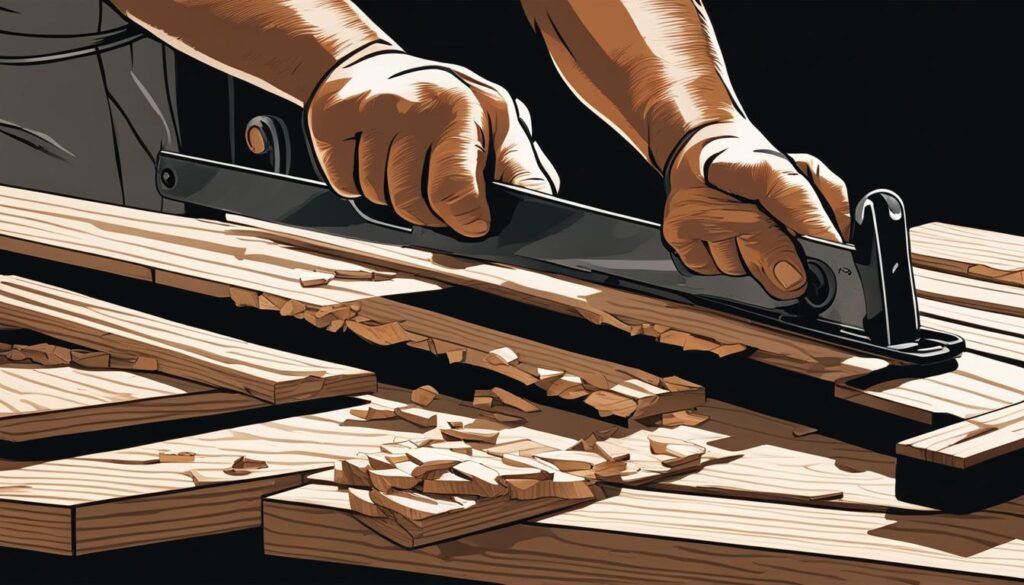We may earn money or products from the companies mentioned in this post.
As a woodworking business owner, you know the importance of quality and craftsmanship. However, creating a successful brand is just as crucial to your long-term success. Brand development encompasses a wide range of strategies, from crafting a compelling brand story to establishing your brand’s visual identity and marketing your products or services effectively. In this article, we’ll explore the key elements of woodworking brand development and provide actionable tips to help you maximize your success in the industry.
Key Takeaways
- Woodworking brand development is a crucial aspect of long-term success in the industry.
- A strong woodworking brand identity can differentiate your business from competitors.
- Effective woodworking brand marketing can increase visibility and generate leads.
- Building brand recognition and reputation is essential to establishing credibility and trust.
- Continuous woodworking brand growth is achievable through strategic partnerships and expanding product lines or services.
Understanding Woodworking Branding Tips
Developing a strong woodworking brand identity is essential for standing out in a competitive market. Here are some valuable tips to help you create a compelling brand:
- Craft a consistent brand story: Your brand story should reflect your business’s values, mission, and unique selling proposition. It should be authentic and relatable to your target audience. Utilize this story across all marketing channels to create a consistent message that resonates with your customers.
- Define your target audience: Understanding your audience’s demographics, psychographics, and behavior is crucial for crafting a brand that appeals to them. Consider their interests, pain points, and aspirations to tailor your messaging and visual identity to their preferences.
- Create a captivating logo: Your logo is the visual representation of your brand and should convey your business’s personality and character. It should be unique, memorable, and easily recognizable. Consider hiring a graphic designer to help you create a professional-looking logo that stands out.
- Choose the right colors and fonts: The colors and fonts you use play a significant role in your brand’s personality and recognition. Choose colors that evoke the emotions and feelings you want associated with your brand. Select fonts that are legible, convey your brand’s tone, and complement your logo and other design elements.
- Be consistent in your branding: Consistency is key in establishing a strong brand identity. Ensure that all marketing materials, from your website to social media posts, have a consistent look and feel. This helps enhance brand recognition and recall, creating a lasting impression on your audience.
- Stay true to your brand values: Your brand values are the foundation of your business. Ensure that all messaging, actions, and decisions are in line with these values. This helps establish trust and credibility with your audience, and sets you apart from competitors who may not have a clear value proposition.
Remember, your brand is your business’s personality. Put in the effort to craft a strong and unique brand identity to help your woodworking business succeed.
Establishing Woodworking Brand Positioning
Positioning your woodworking brand in the market is crucial for success. It enables you to differentiate your business from competitors and communicate your unique selling proposition to potential customers. Here are some strategies for effective woodworking brand positioning:
- Define your target market: Identifying your target audience helps you tailor your brand message to their specific needs and preferences. Conduct market research to learn more about your customers, such as their demographics, buying behaviors, and pain points.
- Analyze market trends: Keep a pulse on industry trends and examine your competitors’ positioning strategies. This information can help you identify gaps in the market and opportunities to distinguish your brand.
- Create a memorable brand message: Craft a clear and concise brand message that resonates with your target customers. Your message should communicate your value proposition, key benefits, and unique selling points.
- Emphasize your USP: Your unique selling proposition (USP) should be a core part of your brand positioning. It’s what sets your business apart from competitors and influences customers to choose your brand over others.
- Align your branding with your business goals: Your branding should align with your business objectives and values. It should communicate what your business stands for and how you plan to deliver value to customers.
- Stay consistent: Consistency is key when it comes to brand positioning. Ensure that your brand message, visual identity, and marketing efforts are aligned and consistent across all channels and touchpoints.
By following these woodworking brand positioning strategies, you can establish a strong brand presence in the market and attract more customers to your business.
Building a Solid Woodworking Brand Identity
Developing a strong woodworking brand identity is crucial to standing out in the competitive marketplace. Your visual brand elements serve as the face of your business and can communicate a lasting impression to potential customers. Here are some key aspects to consider when creating a solid woodworking brand identity:
Design a Compelling Logo
Your logo is the most important visual representation of your brand. It should be memorable, easy to recognize, and reflect your business’s unique personality. Consider working with a professional graphic designer to create a custom logo that effectively communicates your brand story and values.
Choose the Right Colors
The colors you choose for your brand can greatly impact how customers perceive your business. Warm colors like red and orange can convey energy and excitement, while cool colors like blue and green can evoke a sense of calmness and reliability. Whichever colors you choose, ensure they align with your brand’s overall messaging.
Select the Appropriate Typography
The typography you use for your brand can affect the readability and tone of your message. If you want to convey a sense of elegance, consider a cursive or serif font. For a more modern or industrial look, a sans-serif font may be more suitable. Be consistent with your typography choices to maintain a strong brand identity.
Develop Guidelines for Brand Usage
It’s important to develop clear brand guidelines to ensure consistency across all channels and materials. These guidelines should include instructions on logo usage, color palette, typography, and any other visual elements that make up your brand identity. Consistency is crucial to building a recognizable and memorable brand.
“Your brand is what people say about you when you’re not in the room.” – Jeff Bezos
Implementing Effective Woodworking Brand Marketing
Marketing is a crucial aspect of any successful woodworking brand development strategy. By implementing effective marketing tactics, you can increase brand visibility, generate leads, and ultimately boost sales. Here are some woodworking brand marketing tips to consider:
1. Leverage Digital Marketing
Today, more than ever, digital marketing is essential for woodworking businesses. Consider creating a strong online presence by building a website, creating social media accounts, and leveraging search engine optimization (SEO) tactics to boost your online visibility. Additionally, consider leveraging email marketing campaigns, pay-per-click (PPC) advertising, and other digital tactics to reach your target audience.
2. Engage on Social Media
Social media platforms, such as Facebook, Instagram, and Twitter, are excellent resources for engaging with potential customers and building brand awareness. Consider regularly posting content related to your woodworking business, participating in industry-related conversations, and responding to comments and messages to establish a strong online presence and build a loyal following.
3. Create Compelling Content
Content marketing is a powerful tool for showcasing your expertise and building trust with potential customers. Consider creating blog posts, videos, infographics, and other types of content that provide value to your target audience. By doing so, you can establish yourself as a thought leader in the woodworking industry and build a reputation as a trusted source of information.
4. Attend Industry Events
Industry events, such as trade shows and conferences, provide excellent opportunities to network with potential customers and industry peers. Consider attending and participating in events relevant to your woodworking niche to build brand awareness and establish valuable connections within the industry.
5. Partner with Influencers
Influencer marketing can be an effective way to build brand awareness and reach new audiences. Consider partnering with influencers in the woodworking industry who have a strong following and align with your brand values. By doing so, you can tap into their audience and potentially reach new customers.
Achieving Woodworking Brand Recognition
Building a recognizable brand in the woodworking industry takes time and effort. Once you’ve established a solid brand identity, it’s crucial to focus on building brand recognition and reputation.
A great way to start is by leveraging customer testimonials. Ask satisfied customers to leave feedback on your website or social media pages. Use these testimonials to highlight the quality of your products and services.
Participation in industry events is another effective way to build brand recognition. Attend trade shows and conferences to showcase your products and connect with potential customers and industry influencers.
It’s also essential to optimize your online presence. Ensure your website is user-friendly, visually appealing, and reflects your brand’s personality. Use relevant keywords and phrases in your content to improve your search engine ranking and increase brand visibility.
Remember, building a recognizable brand takes time and consistency. Be patient, stay true to your brand’s core values, and keep providing high-quality products and services to your customers.
Nurturing Woodworking Brand Growth
Building a successful woodworking brand takes effort, dedication, and perseverance. Once your brand has been established, it’s essential to focus on nurturing its growth to ensure its longevity and success. Here are some effective techniques for sustaining and scaling your woodworking brand.
1. Partnering with Influencers
Collaborating with influencers can be a powerful way to expand your reach and increase brand awareness. Identify influencers within the woodworking industry who share your values and have a significant following. Reach out to them and propose a partnership. Consider offering them exclusive access to your products or services in exchange for their endorsement on social media or other platforms. By partnering with influencers, you can leverage their credibility to attract new customers and promote your brand.
2. Expanding Your Product Line
Expanding your product line is another effective way to grow your woodworking brand. Consider introducing new products or services that complement your existing offerings. Research your target audience to identify their needs and preferences, and use this information to develop new products that meet their demands. Be sure to market your new products effectively to generate interest and drive sales.
3. Engaging with Customers
Engaging with customers is essential for building a loyal following for your woodworking brand. Encourage customers to share their experiences with your products or services on social media, and respond promptly to any feedback or queries. Consider hosting events or workshops where customers can interact with your brand and learn more about your woodworking techniques and processes. By fostering a strong relationship with your customers, you can create a loyal following that will support your brand for years to come.
4. Optimizing Your Online Presence
In today’s digital age, having a strong online presence is essential for growing your woodworking brand. Ensure that your website is well-designed, user-friendly, and optimized for search engines. Use social media to connect with your target audience and promote your brand. Create valuable content that showcases your expertise and builds trust with potential customers. Consider investing in paid advertising to increase your brand visibility and drive traffic to your website. By optimizing your online presence, you can reach a wider audience and grow your woodworking brand more effectively.
5. Continuous Improvement
Finally, to nurture the growth of your woodworking brand, you must be committed to continuous improvement. Continuously monitor market trends and customer feedback to identify opportunities for growth and innovation. Stay up-to-date with the latest woodworking techniques and technologies to ensure that your products and services remain competitive. Regularly review your branding and marketing strategies to identify areas for improvement and adjustments. By continuously improving and evolving your woodworking brand, you can stay ahead of the competition and achieve long-term success.
Conclusion
Developing a strong woodworking brand requires careful planning and execution. By following the strategies outlined in this article, you can establish a unique and compelling brand identity that resonates with your target customers. Remember to focus on building a solid brand foundation by crafting a compelling brand story, identifying your unique selling proposition, and positioning your brand effectively in the market.
Invest time and resources into creating a captivating brand identity by designing a memorable logo, choosing the right colors and fonts, and creating a consistent visual language across all your marketing channels. From there, focus on implementing effective marketing strategies that can help increase your brand visibility and generate leads.
Building lasting brand recognition and reputation requires consistent effort and nurturing. Leverage customer testimonials, participate in industry events, and optimize your online presence to establish credibility and trust.
Finally, remember that sustaining brand growth requires continuous innovation and adaptation. Keep an eye on market trends, explore strategic partnerships, and consider expanding your product lines or services.
By implementing these woodworking brand development strategies, you can achieve long-term success in the industry and stand out among competitors.
FAQ
What is woodworking brand development?
Woodworking brand development refers to the process of creating and enhancing a unique brand identity for a woodworking business. It involves defining the brand’s values, positioning in the market, and implementing strategies to establish recognition and reputation.
Why is woodworking brand development important?
Woodworking brand development is crucial for businesses in this industry as it helps differentiate them from competitors and attract customers. It establishes trust, credibility, and recognition, which can lead to increased sales, customer loyalty, and long-term success.
What are some woodworking branding tips?
Some essential woodworking branding tips include crafting a compelling brand story, defining your target audience, creating a consistent visual identity, and delivering exceptional customer experiences. These tips help build a strong brand that resonates with customers and sets your business apart.
How can I position my woodworking brand effectively?
To position your woodworking brand effectively, you should identify your unique selling proposition, analyze market trends and competition, and develop a memorable brand message. This involves understanding your target customers’ needs and preferences and aligning your brand values with their expectations.
What elements contribute to a strong woodworking brand identity?
A strong woodworking brand identity consists of various elements such as a captivating logo, consistent visual design (colors, fonts, imagery), brand voice and tone, and a cohesive brand message. These elements help create a recognizable and memorable brand that customers can connect with.
What are some effective woodworking brand marketing strategies?
Some effective woodworking brand marketing strategies include leveraging digital marketing tactics like search engine optimization (SEO), social media engagement, content marketing, influencer collaborations, and participating in industry events. These strategies help increase brand visibility and attract potential customers.
How can I build brand recognition for my woodworking business?
Building brand recognition for your woodworking business involves leveraging customer testimonials, optimizing your online presence (including your website and social media profiles), participating in industry-specific events and exhibitions, and consistently delivering high-quality products and services.
What can I do to nurture woodworking brand growth?
To nurture woodworking brand growth, you can consider forming strategic partnerships and collaborations, expanding your product lines or services, exploring new markets, and continuously seeking feedback from customers to improve your offerings. These actions contribute to sustained growth and expansion.
Affiliate Disclosure: This post may contain affiliate links. If you purchase through our link, we may receive a small commission, but at no additional cost to you. For more information, please see our Disclosure statement.



